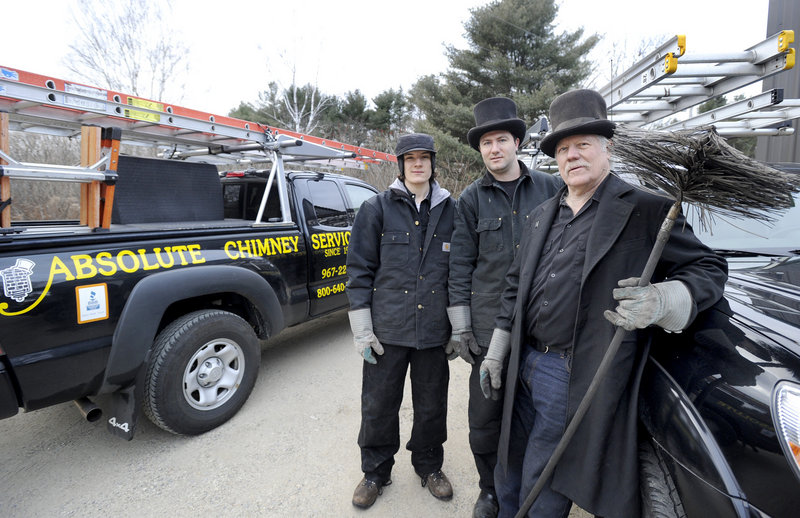Q: How long have you been a chimney sweep?
A: 31 years.
Q: How did you get into this line of work?
A: I read an article in Mother Earth magazine on chimney sweeping. It was a job that not a lot of people wanted to do but it was a niche market and I wanted to start my own business. So I contacted the August West Chimney Systems from Connecticut, who had developed a vacuum specifically for cleaning chimneys. They sent me an information packet that included a sheet on the dangers of chimney fires. I printed off 500 copies of that, put my business contact information on the bottom and gave the fliers out to potential customers. I got 15 call-backs that first week from people seeking my services.
Q: Did you have to have special training.
A: Most of it was on-the-job training. But I am CSI (Chimney Safety Institute of America) certified and I’m also am certified with the F.I.R.E. (Fireplace Investigation Research and Education) Certified Inspector Program. That certification turned out to be really good for our business because it taught us a lot of things that we needed to know about being up to fire code — things that are not required by the state. I also have a Maine master solid-fuel license that allows me to install solid-fuel heating burners and boilers for people who use wood- or coal-fired heating systems instead of oil.
Q: How often should homeowners have their chimney cleaned?
A: Once per year for those who burn solid fuel (wood or coal) and once every two or three years for those who have an oil burner, unless there is a problem. The issue is that most people, who use their wood stove as the primary source of heat, tend to fill it with wood then close the draft, and sometimes the damper, and let it chug along slowly for eight hours while they are at work. Then, they repeat the process when they get home. When wood is burned slowly like that, it produces more creosote buildup on the chimney lining. If the stove is not properly and regularly stoked to burn off that buildup, the greater the risk of starting a chimney fire.
Q: Do you discover a lot of chimney liner cracks?
A: Yes. This past year alone, a full two-thirds of our business has been installing new liners.
Q: How should homeowners proceed if they find themselves with a cracked liner?
A: If we discover the problem, we take pictures to document the damage using a digital camera. Then we work with the homeowners to get their insurance company a copy of our inspection report, including photos of the damage and a proposal detailing the cost of repairs.
Q: What are the tools of your trade?
A: Cleaning brushes, rods, hook ladders, LED flashlight, mirrors and a big vacuum so that we don’t get any dust in the house. We recently acquired a new power rotary cleaning system that is much more effective at removing creosote than using a traditional brush. It uses a head that has plastic whip lines on it, like you’d see on a Weed Wacker. That is fitted on the end of a rod and spins like a drill to remove creosote buildup on the chimney liner. For tougher jobs, we’ll use a head fitted with metal chains. And, since there is image associated with this line of work, we also dress for the job. The master sweep for that day always wears a top hat and topcoat just like the old chimney sweeps from England did. I feel that helps us stand out from the competition.
Q: Do customers every ask you to have their pictures taken with them in your uniform?
A: Absolutely.
Q: What is the best time to have your chimney cleaned?
A: I recommend early spring or summer. That allows us to address any problems before our busy season begins, in the fall. We usually mail out cleaning reminder postcards to our customers in May offering a discount for jobs booked before July 31.
Q: What other kinds of services do you offer?
A: We do inspections, repairs and install caps, top dampers, screens to keep animals out and waterproofing. We also do some light masonry work. But we don’t do flashing. That gets into a whole other line of roofing work.
Q: Ever fall off a roof?
A: Never. Actually, we only spend about 50 percent of our time on the roof. You can see more of the parts of the chimney that you need to see from the ground. Much of the cleaning is done with newer equipment that allows us to clean from the bottom up. We get up (on the roof) if we see there is a problem on that end. Roofs aren’t designed to be walked on. You can damage the roofing shingles.
Staff Writer Deborah Sayer can be contacted at 791-6308 or at: dsayer@pressherald.com
Send questions/comments to the editors.



Success. Please wait for the page to reload. If the page does not reload within 5 seconds, please refresh the page.
Enter your email and password to access comments.
Hi, to comment on stories you must . This profile is in addition to your subscription and website login.
Already have a commenting profile? .
Invalid username/password.
Please check your email to confirm and complete your registration.
Only subscribers are eligible to post comments. Please subscribe or login first for digital access. Here’s why.
Use the form below to reset your password. When you've submitted your account email, we will send an email with a reset code.